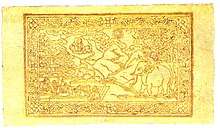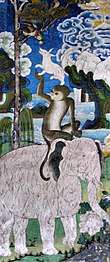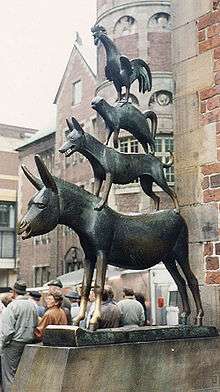Four harmonious animals
The tale of the four harmonious animals, four harmonious friends or four harmonious brothers Standard Tibetan: མཐུན་པ་སྤུན་བཞི། (Wylie: mthun pa spun bzhi [1] or Wylie: mthun pa rnam bzhi [2]) is one of the Jātaka tales, part of Buddhist mythology, and is often the subject in works of Bhutanese and Tibetan art. It is perhaps the most common theme in Bhutanese folk art, featuring on many temple murals, stupas, and as a decorative pattern on many daily utensils.[3][4]:108[5]:53 It is the best-known national folktale of Bhutan and is popular in Tibet and Mongolia:[4]:107[6] it is widely referred to in these cultures.[7][8][9]
| Four harmonious animals | |
|---|---|
| Information | |
| Religion | Buddhism |
| Language | Pāli, Sanskrit, Tibetic languages |
| Sutras | In Vinaya texts and Jātaka collections of many Buddhist canons |
Outline of story

A popular scene often found as wall paintings in Tibetan religious buildings represents an elephant standing under a fruit tree carrying a monkey, a hare and a bird (usually a partridge, but sometimes a grouse, and in Bhutan a hornbill) on top of each other.[10] The scene refers to a legend which tells that four animals were trying to find out who was the oldest. The elephant said that the tree was already fully grown when he was young, the monkey that the tree was small when he was young, the hare that he saw the tree as a sapling when he was young and the bird claimed that he had excreted the seed from which the tree grew. So the bird was recognized by the other animals as the oldest, and the four animals lived together in co-dependence and cooperation, helping each other to enjoy the fruits of the tree. After the story is finished, it is revealed the partridge was the Buddha in a previous life.[11][5]:51 The story was meant as an illustration of cooperation and respect for seniority, and was told by the Buddha after some of his students had failed to pay due respect to the senior disciple Śāriputra.[7][12] Sometimes the tale also describes the animals upholding the five precepts and teaching them to others.[13] One of the oldest extant forms of the story is the Pāli version, called the Tittira Jataka.[5]:51
Themes

Communal harmony and respect for seniority are the main moral of the story. Such respect stands in contrast with a pecking-order according to strength, size and power: it is the partridge which is most respected, not the elephant.[13] Although the Buddha did sometimes downplay the value respecting older people merely for their age, in this story he illustrates that a senior person should nonetheless be respected for their experience, because, as Tachibana points out, "the maturity of age is generally the sign of much experience".[14] However, the story led to the establishment of several rules of conduct with regard to respect for seniority in the context of the monastic life, in which the number of years ordained as a monk (Sanskrit: bhikṣu; Pali: bhikkhu) is measured, rather than age.[11][15] Buddhist monk Thanissaro Bhikkhu explains the relation between respect for seniority and harmony, drawing from the story: "A hierarchy based on seniority, however, is both objective and, in the long run, less oppressive: one's place in the hierarchy is not a measure of one's worth. Such a hierarchy also discourages the pride and competition that would come if bhikkhus could fight their way up the hierarchy by outdoing the measurable merit of others."[16]
The four animals represent the different habitats of the animal world—the sky, the trees, the ground, and underground.[5]:51 The partridge assumes the role of the most senior animal: in pre-modern India, the partridge was highly regarded for its intelligence and understanding of language.[17] The excreting of the seed of the tree is relevant, because some Indian trees are believed to only sprout when the seed is excreted by a bird, thus further amplifying the concept of cooperation and mutual dependence.[5]:53 The image of the animals standing on each other’s shoulders, on the back of a patient elephant, also portrays social and environmental harmony: the bird finds a seed and plants it, then the rabbit waters it, and the monkey fertilizes it. Once the seed sprouts and begins to grow, the elephant protects it. After some time, the small plant grows into a big, beautiful tree full of healthy fruit. By working together and using their individual talents, the four friends are able to reach and enjoy the fruit.[18]
Origins

The primary source for the Buddhist legend of the four harmonious brothers is the Vinayavastu (Wylie: 'dul ba'i gzhi ), which forms the first section of the Kangyur, the canon of Tibetan Buddhism.[4]:107[2] In canons of other Buddhist traditions, such as in the Pāli Canon of Theravāda Buddhism, and in the texts of the Mahāsāṃghika, Mūla-Sarvāstivāda and Sarvāstivāda orders, almost the same Jātaka tale is found in the Vinaya and Jātaka collections. The Dharmaguptaka and Mahīśāsaka orders did not consider the story part of the Jātaka, however, and only included it in their Vinayas. Bhikkhu Analayo believes that the story originally was not considered a previous life of the Buddha, but a didactic parable taught by the Buddha.[19]
Similar motifs worldwide
Old Irish scholar Eleanor Hull has pointed out that the story may reveal a custom of the ancient world to determine the date based on the life spans of different animals. Stories dealing with the question which animal lives the longest are found throughout the world. Most versions of the story usually feature three animals, as indeed, the Pali and Chinese versions of the Jātaka do.[20][21] As for the fourth animal not present in the Pāli version, the hare—it was included in later versions.[5]:51[22]
A similar story was made famous when the Brothers Grimm included it in their collection of folk tales, as the "Town Musicians of Bremen".[4]:107[5]:53
References
- Lama, Gege (1983). Principles of Tibetan Art. II. Darjeeling. p. 241.
- Sagaster, Klaus (December 1978). Der weiße Lotus des Friedens. Eine moderne Interpretation Buddhistischer Symbolik [The White Lotus of Peace: A Modern Interpretation of Buddhist Symbolism] (in German). Harrassowitz, Wiesbaden: Zentralasiatische Studien, Sonderdruck.
- Carpenter, Russel B.; Carpenter, Blyth C. (2002). The blessings of Bhutan. Latitude 20. Honolulu: University of Hawai'i Press. p. 89. ISBN 978-0-8248-2679-6.
- Dagyab, Loden Sherap (2016). Buddhist Symbols in Tibetan Culture: An Investigation of the Nine Best-Known Groups of Symbols. Translated by Walshe, Maurice. Simon and Schuster. ISBN 978-0-86171-810-8.
- Beer, Robert (2003). The Handbook of Tibetan Buddhist Symbols (1st ed.). Chicago: Serindia. ISBN 978-1-932476-03-3.
- Evans, Steve (2009). "The impact of cultural folklore on national values: A preliminary study with a focus on Bhutan" (PDF). Storytelling, Self, Society. 6 (1): 12. ISSN 1550-5340.
- Richard, Whitecross (1 January 2010). ""Virtuous Beings": The Concept of tha damtshig and Being a Moral Person in Contemporary Bhutanese Society". Himalaya, the Journal of the Association for Nepal and Himalayan Studies. 28 (1): 77. ISSN 2471-3716.
- Bischoff, Jeannine; Mullard, Saul (2016). Social Regulation: Case Studies from Tibetan History. Brill's Tibetan Studies Library. Brill. p. 114. ISBN 9789004331259.
- McGranahan, Carole (2005). "In Rapga's Library: the Texts and Times of a Rebel Tibetan Intellectual" (PDF). Cahiers d'Extrême-Asie. 15 (1): 265. doi:10.3406/asie.2005.1228.
- Gruschke, Andreas (2001). The Cultural Monuments of Tibet's Outer Provinces: The Qinghai part of Amdo. The Cultural Monuments of Tibet's Outer Provinces: Amdo. 1. Bangkok: White Lotus Press. p. 243. ISBN 978-9747534597.
- Chalmers, Robert (1895). "Tittira Jātaka". The Jataka. I.
- Malalasekera, G.P. (1938). "Tittira Jātaka (No.37)". Dictionary of Pāli Proper Names. 2. Pali Text Society.
- Penjore, Ugyen (2 August 2005). "Understanding the symbolism of Thuenpa Puen Zhi". Kuensel Online. Retrieved 28 January 2017 – via The Buddhist Channel.
- Tachibana, S. (1992). The ethics of Buddhism (Facsim. ed.). Richmond, Surrey: Curzon Press. p. 224. ISBN 978-0-7007-0230-5.
- Shaw, Sarah (2006). The Jatakas: Birth Stories of the Bodhisatta. Penguin UK. ISBN 9788184750348.
- Bhikkhu, Thanissaro (2013). The Buddhist Monastic Code (PDF). II (3rd ed.). California: Metta Forest Monastery. p. 92.
- Gutiérrez, Andrea Lorene (December 2014). The Parrot’s Voice and the Partridge’s Feathers: The Languaging of Animals and Animal Language in Early Indian Texts (M.A. Thesis). The University of Texas.
- "The Four Harmonious Friends" (PDF). Smithsonian Center for Folklife and Cultural Heritage. 12 June 2008.
- Anālayo, Bhikkhu (2012). "Canonical Jātaka Tales in Comparative Perspective: The Evolution of Tales of the Buddha's Past Lives" (PDF). Fuyan Buddhist Studies. 7. ISSN 2070-0512.
- Hull, Eleanor (December 1932). "The Hawk of Achill or the Legend of the Oldest Animals". Folklore. 43 (4): 376–409. doi:10.1080/0015587X.1932.9718462.
- Ralston, W.R.S. (2012). The Bible of Tibet: Tibetan Tales from Indian Sources. Routledge. p. 302. ISBN 978-1-136-20297-1.
- Kimball, Mike (2016). "Our heritage is already broken: meditations on a regenerative conservation for cultural and natural heritage". Human Ecology Review: 13. doi:10.4225/13/581fcdf8dc329. hdl:1885/100985.